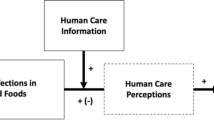Abstract
Over the earlier decades of the last century, researchers began to explore the use of people as “measuring instruments.” For food, this systematized effort began in earnest with ratings of liking of different products, with such ratings being analyzed for differences (Peryam and Pilgrim 1957). Measurement by itself, no matter how well executed, was not sufficient. It would take a change of world view, from measure of single items or happenstance discovery of relation to the world of systematics, DOE, design of experiments.
Similar content being viewed by others
References
Box, G. E., Hunter, J. S., & Hunter, W. G. (2005). Statistics for experimenters: Design, innovation, and discovery (Vol. 2). New York: Wiley-InterScience.
Cochran, W. G. (1950). Experimental design. New York: Wiley.
Gladwell, M. (2012). TED radio hour. https://www.npr.org/2012/05/04/151899611/malcolm-gladwell-what-does-spaghetti-sauce-have-to-do-with-happiness
Moskowitz, H. R. (1972). Subjective ideals and sensory optimization in evaluating perceptual dimensions in food. Journal of Applied Psychology, 56, 60–66.
Moskowitz, H. R. (1994). Food concepts and products: Just-in-time development. Trumbull: Food and Nutrition Press.
Moskowitz, H. R. (2001). Sensory directionals for pizza: A deeper analysis. Journal of Sensory Studies, 16, 583–600.
Moskowitz, H. R., Wolfe, K., & Beck, C. (1979). Sweetness and acceptance optimization in cola flavored beverages using combinations of artificial sweeteners—A psychophysical approach. Journal of Food Quality, 2, 17–26.
Moskowitz, H. R., Porretta, S., & Silcher, M. (2008). Concept research in food product design and development. New York: Wiley.
Peryam, D. R., & Pilgrim, F. J. (1957). The hedonic scale method of measuring food preference. Food Technology, 11(January), 32.
Author information
Authors and Affiliations
Corresponding author
Editor information
Editors and Affiliations
Rights and permissions
Copyright information
© 2019 Springer Nature Switzerland AG
About this entry
Cite this entry
Moskowitz, H.R. (2019). Commercial Product Design: Psychophysics, Systematics, and Emerging Opportunities. In: Meiselman, H. (eds) Handbook of Eating and Drinking. Springer, Cham. https://doi.org/10.1007/978-3-319-75388-1_151-1
Download citation
DOI: https://doi.org/10.1007/978-3-319-75388-1_151-1
Received:
Accepted:
Published:
Publisher Name: Springer, Cham
Print ISBN: 978-3-319-75388-1
Online ISBN: 978-3-319-75388-1
eBook Packages: Springer Reference Behavioral Science and PsychologyReference Module Humanities and Social SciencesReference Module Business, Economics and Social Sciences



